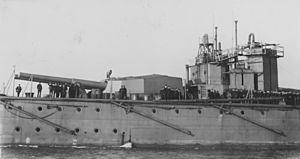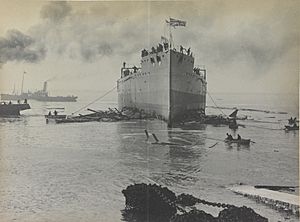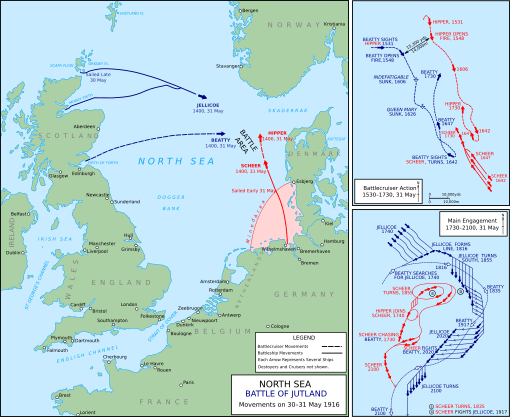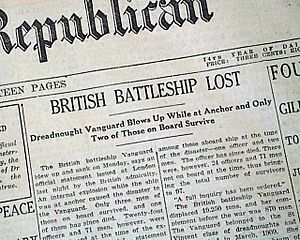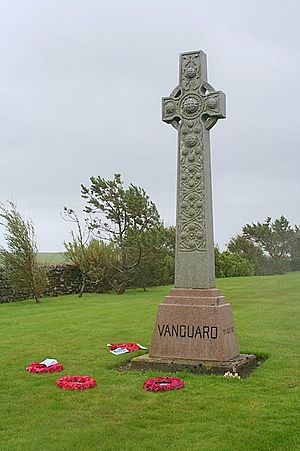HMS Vanguard (1909) facts for kids
HMS Vanguard was a powerful warship, known as a dreadnought battleship, built for the Royal Navy in the early 1900s. She was one of three ships in her class, called the St Vincent class. Vanguard served in the Home Fleet and later the Grand Fleet. Her time during World War I mostly involved regular patrols and training in the North Sea. She also took part in the big Battle of Jutland in May 1916.
Tragically, on 9 July 1917, while anchored at Scapa Flow, Vanguard was destroyed by a series of huge explosions inside the ship. She sank almost immediately, and 843 out of 845 men on board lost their lives. The ship's wreck was later explored and some parts were removed. Today, it is a protected war grave, meaning it's a special place where the lost sailors are remembered, and diving on it is usually not allowed.
| Top - 0-9 A B C D E F G H I J K L M N O P Q R S T U V W X Y Z |
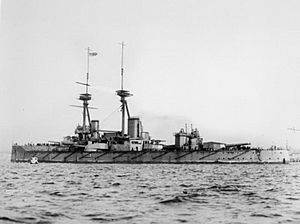
Vanguard, 1910
|
|
Quick facts for kids History |
|
|---|---|
| Name | Vanguard |
| Ordered | 6 February 1908 |
| Builder | Vickers, Barrow-in-Furness |
| Laid down | 2 April 1908 |
| Launched | 22 February 1909 |
| Commissioned | 1 March 1910 |
| Fate | Sunk by internal explosion at Scapa Flow, 9 July 1917 |
| Status | Protected war grave |
| General characteristics (as built) | |
| Class and type | St Vincent-class dreadnought battleship |
| Displacement | 19,700 long tons (20,000 t) (normal) |
| Length | 536 ft (163.4 m) (o/a) |
| Beam | 84 ft (25.6 m) |
| Draught | 28 ft (8.5 m) |
| Installed power |
|
| Propulsion | 4 × shafts; 2 × steam turbine sets |
| Speed | 21 knots (39 km/h; 24 mph) |
| Range | 6,900 nmi (12,800 km; 7,900 mi) at 10 knots (19 km/h; 12 mph) |
| Complement | 753 |
| Armament |
|
| Armour |
|
Building and Design of HMS Vanguard
The St Vincent class of battleships, which included Vanguard, was an improved version of an earlier ship called the Bellerophon class. Vanguard was a bit bigger, had stronger armour, and more powerful guns.
Ship's Size and Crew
Vanguard was 536 feet (163.4 m) long from front to back. She was 84 feet (25.6 m) wide and sat 28 feet (8.5 m) deep in the water. The ship weighed about 19,700 long tons (20,000 t) when fully loaded. In 1910, her crew was made up of 753 officers and sailors.
Engines and Speed
Vanguard was powered by two sets of steam turbines, which are like powerful engines that use steam. These turbines turned four shafts, making the ship move. The steam came from eighteen large Babcock & Wilcox boilers. These engines were designed to give the ship a top speed of 21 knots (39 km/h; 24 mph) (about 24 miles per hour). During trials, she even reached an unofficial speed of 22.3 knots (41.3 km/h; 25.7 mph) (about 25.7 mph). Vanguard could travel about 6,900 nautical miles (12,800 km; 7,900 mi) (about 7,940 miles) at a slower speed of 10 knots (19 km/h; 12 mph) (about 11.5 mph).
Powerful Guns and Protection
The St Vincent class ships had ten large 12-inch (305 mm) guns. These were placed in five twin-gun turrets. Three turrets were along the middle of the ship, and two were on the sides.
For protection against smaller, faster ships like torpedo boats, Vanguard had twenty smaller 4-inch (102 mm) guns. Some of these were on top of the main gun turrets, and others were in the ship's upper structure. The ship also had three 18-inch (450 mm) torpedo tubes for firing torpedoes.
The ship was protected by a thick armoured belt along its waterline, which was 8–10 inches (203–254 mm) thick. Her decks were between 0.75 to 3 inches (19 to 76 mm) thick, with the thickest parts protecting the steering gear. The front of the main gun turrets had 11 inches (279 mm) thick armour.
Changes Over Time
Over the years, Vanguard had some updates. In 1910–1911, some guns on the front turret were removed. Later, shields were added to most of the 4-inch guns for better protection. The bridge area was also made larger.
During World War I, more changes were made. Eight 4-inch guns were moved, and the guns on top of the turrets were taken off. Two anti-aircraft (AA) guns were added to shoot down enemy aircraft. Before the Battle of Jutland in May 1916, a special device called a fire-control director was installed high up on the front mast to help aim the guns better. After the battle, about 50 long tons (51 t) of extra armour was added to the deck for more protection.
Service History of HMS Vanguard
Vanguard was the eighth Royal Navy ship to carry that name. She was ordered on 6 February 1908 and built by Vickers Armstrong in Barrow-in-Furness. The ship was launched on 22 February 1909 and finished on 1 March 1910. Building her cost about £1.6 million.
Vanguard officially joined the Royal Navy on 1 March 1910. She was part of the 1st Division of the Home Fleet. She took part in a fleet review for King George V in 1910 and the Coronation Fleet Review in 1911.
World War I Service
Before World War I started in July 1914, Vanguard took part in a test of the fleet's readiness. To prevent a surprise attack from the Imperial German Navy, she sailed with the rest of the Home Fleet to Scapa Flow. When the war began in August 1914, the Home Fleet became the Grand Fleet, led by Admiral John Jellicoe.
In the early days of the war, there were often false alarms about German submarines. Vanguard even fired at what was thought to be a periscope once, but it turned out to be nothing. These scares led the fleet to move to Lough Swilly, Ireland, for a short time while defences at Scapa Flow were made stronger.
Vanguard and the Grand Fleet often went on patrols in the North Sea and practiced their gunnery skills. They tried to find and engage the German fleet, but often without success due to bad weather or the Germans avoiding battle. For example, they sailed during the German raid on Scarborough, Hartlepool and Whitby but couldn't find the German ships.
In 1915, the Grand Fleet continued its training and patrols. They swept the North Sea many times, but rarely met German ships. In April 1916, Vanguard was moved to the 4th Battle Squadron.
Battle of Jutland
The Battle of Jutland was the biggest naval battle of World War I. It happened on 31 May 1916. The German High Seas Fleet tried to trick and destroy a part of the British Grand Fleet. However, the British had intercepted German radio messages and knew their plans. So, the Grand Fleet, including Vanguard, sailed out to meet them.
During the battle, Vanguard was the eighteenth ship in the British battle line. She fired her main 12-inch guns at a damaged German light cruiser called SMS Wiesbaden, hitting it several times. Later, she also fired at some German destroyers. This was the last time Vanguard fired her guns in the battle. The battle ended without a clear winner, as bad visibility allowed the German fleet to escape under the cover of darkness.
After Jutland
After the Battle of Jutland, the Grand Fleet tried to ambush the German fleet again in August 1916. However, due to communication problems, they couldn't find the German ships. After this, the British decided not to risk their large warships in the southern North Sea because of the danger from German U-boats (submarines) and mines. Vanguard had a refit (repairs and upgrades) in December 1916.
The Explosion of HMS Vanguard
On 9 July 1917, Vanguard was anchored safely in Scapa Flow after a day of training. Around 11:20 PM, a small explosion was seen on the ship, followed very quickly by two much larger explosions. Vanguard sank almost immediately.
Out of 845 men on board, only three survived, and one of them died soon after. In total, 843 men were lost. This included two Australian sailors who were in the ship's brig (prison) and a Japanese military observer. The bodies of 17 men were found and buried at the Royal Naval Cemetery at Lyness. The others are remembered on naval memorials in Chatham, Plymouth, and Portsmouth Naval Memorial.
An investigation was held to find out why the ship exploded. Witnesses from nearby ships said they saw a white flash and small explosion near the front of the ship, followed by two huge blasts. The investigators believed the main explosions happened in the ship's magazines, which stored the cordite (explosive material) for the guns.
The exact reason for the explosion was not clear. One idea was that some of the cordite on board was old and might have exploded on its own. Another idea was that some of the ship's boilers were still running, and some watertight doors were open, which could have made the magazines dangerously hot. The final conclusion was that a fire probably started in a smaller 4-inch gun magazine, possibly due to heat, and then spread to the main magazines, causing the massive explosions.
The Wreck of HMS Vanguard
After the war, Vanguard's wreck was heavily salvaged, meaning parts of it were removed, especially valuable metals. In 1984, the wreck was officially declared a war grave.
The wreck lies about 34 metres (111 ft 7 in) (about 111 feet) deep. The middle part of the ship is almost completely destroyed, and some of the gun turrets were blown far away. However, the front and back parts of the ship are still mostly in one piece. A detailed survey by volunteer divers in 2016 helped understand the wreck better.
Since 2002, the wreck has been a controlled site, meaning you need special permission from the Ministry of Defence to dive on it. On 9 July 2017, 100 years after the explosion, a special ceremony was held. Descendants of the crew laid wreaths over the wreck, Royal Navy divers placed a new flag on it, and a ceremony was held at the Lyness Royal Naval Cemetery.
Images for kids
See also
 In Spanish: HMS Vanguard (1909) para niños
In Spanish: HMS Vanguard (1909) para niños


